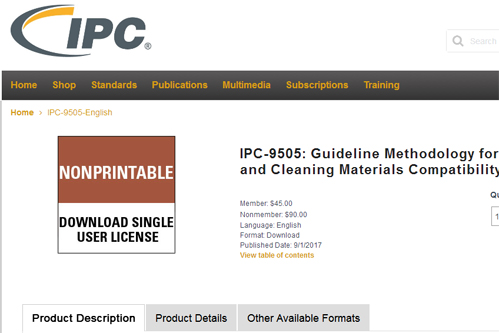| The electronics industry (QTA PCB) has long relied on cleaning chemistry material references and cleaning compatibility methods that are decades old and not representative of current chemistries and processes. Currently, the industry uses Mil-Std-202, Method 215, which contains references to cleaning chemistries and cleaning equipment that are no longer used in general electronics manufacturing processes and lacks reference to test methods that replicate the newer cleaning processes. |
| To address this problem, the IPC’s 5-31j Cleaning Compatibility Task Group introduced an alternative to Mil-Std-202, Method 215 with the release of, IPC-9505, (QTA PCB)Guideline Methodology for Assessing Component and Cleaning Materials Compatibility, which provides the industry with methods and procedures for component compatibility analysis that are relevant to current electronic assembly processes. IPC-9505 establishes uniform methods for testing electronic and electrical components |
 |
| “IPC-9505 is the result of a need to replace the Mil-Std-202 Method 215,” said Eddie Hofer, Rockwell Collins, chair of the 5-31j Cleaning Compatibility Task Group. “The main issue with Mil-Std-202 (QTA PCB)is that chemicals used in current electronic assembly processes are not represented in the document, and new test methods were needed to address new chemistries and processes.” |
| IPC-9505 addresses material compatibility risks when cleaning electronic hardware, including issues relating to FPC board laminates, surface finishes, components, metal alloys, adhesive bond strength, part markings, plastics, the mix and configuration of materials in the assembly and the impact of entrapped contaminants. |
| |
|





